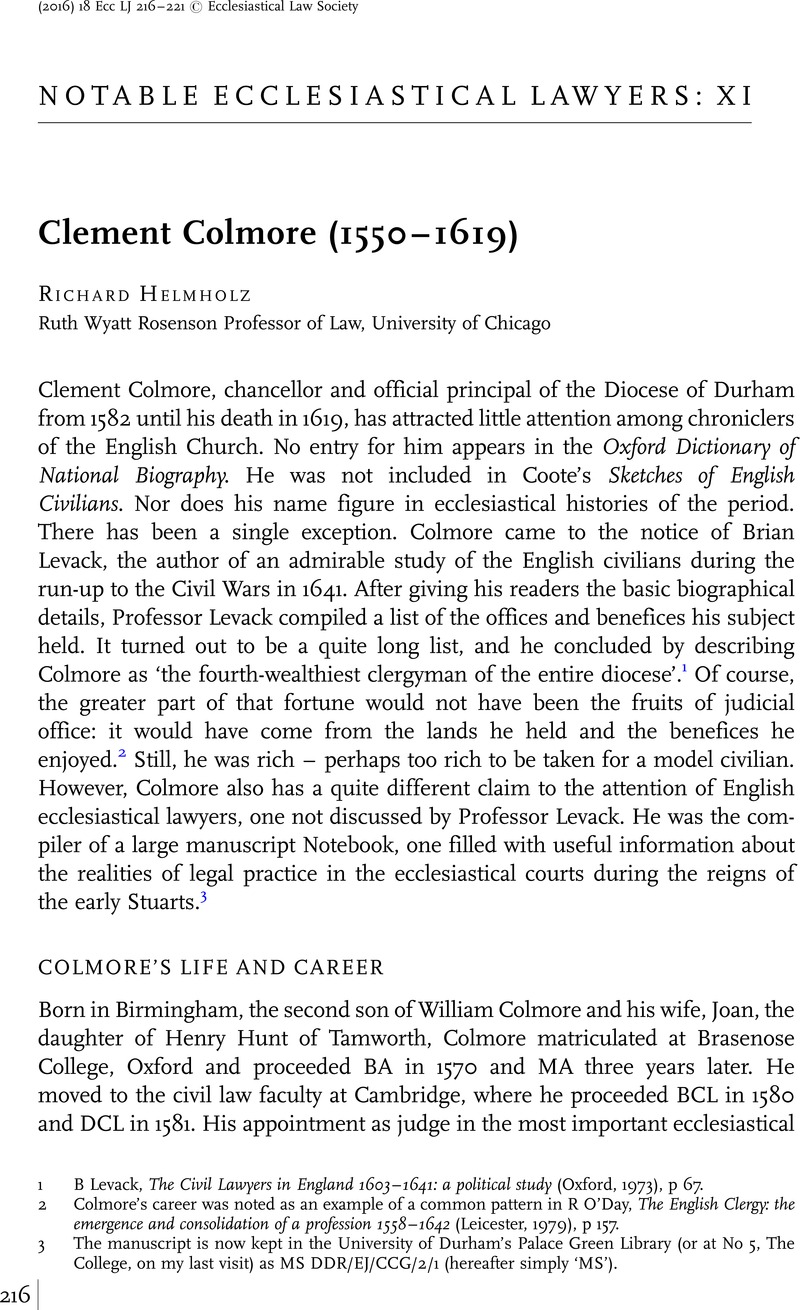No CrossRef data available.
Article contents
Clement Colmore (1550–1619)
Published online by Cambridge University Press: 15 April 2016
Abstract

Information
- Type
- Notable Ecclesiastical Lawyers: XI
- Information
- Copyright
- Copyright © Ecclesiastical Law Society 2016
References
1 B Levack, The Civil Lawyers in England 1603–1641: a political study (Oxford, 1973), p 67.
2 Colmore's career was noted as an example of a common pattern in R O'Day, The English Clergy: the emergence and consolidation of a profession 1558–1642 (Leicester, 1979), p 157.
3 The manuscript is now kept in the University of Durham's Palace Green Library (or at No 5, The College, on my last visit) as MS DDR/EJ/CCG/2/1 (hereafter simply ‘MS’).
4 See G Squibb, Doctors' Commons: a history of the college of advocates and doctors of law (Oxford, 1977), p 205. His name was not mentioned in C Coote, Sketches of the Lives and Characters of Eminent English Civilians (London, 1804).
5 See eg the Durham court's Act book for 1608–1610, DDR/EJ/CCA/1/7, f 9v, describing him as vicar general as well as official principal.
6 E White (transcriber), Baptismal, Marriage, and Burial Registers of the Cathedral Church of Christ … at Durham 1609–1896, ed G Armytage, Publications of the Harleian Society 23 (London, 1897), p 83.
7 Some of these are described in R Helmholz, Roman Canon Law in Reformation England (Cambridge, 1990) pp 121–157.
8 They are found at MS, f 217r–v (Swinburne); f 218 (Talbot); ff 210–211, 235 (Hudson). For biographies of Talbot, see Levack, Civil Lawyers in England, p 274; for Hudson, see Squibb, Doctors' Commons, p 165.
9 MS, ff 235–236.
10 MS, f 2. Another example is found in J Derrett, Henry Swinburne (?1551–1624): civil lawyer of York (York, 1973), pp 29–31. See also J Baker, Monuments of Endlesse Labours: English canonists and their work 1300–1900 (London, 1998), pp 59–60.
11 See R Outhwaite, The Rise and Fall of the English Ecclesiastical Courts, 1500–1860 (Cambridge, 2006), pp 33–39.
12 MS, ff 235–236 (dealing with the requisite size of the estate, the problems raised by inter vivos transfers and the ambiguous status for jurisdictional purposes of leases of land).
13 MS, f 223 (difficulties of proof raised by the objection that witnesses to the exchange of matrimonial consent heard the spoken words imperfectly and slightly differently).
14 MS, f 254v (According to the entry the debts were to be paid with the following priority: debts to the crown, debts provable by official records; debts evidenced by a speciality; servants' wages, rents and similar obligations; all others).
15 Slingsbie c Urpath, MS, f 211 (reference to X 2.26.7 and Rebuffi's treatise ad Quaest 13, nos 64 et seq).
16 Clesasbye c Collingwood, MS, f 231r–v (reference was to his Commentaria ad X 2.24.36). The entry is enlivened by the remark, at f 121v, that one of the lawyers involved in the case ‘offered to laie 100s. to 4d. [that] Panormitanus had no such place’.
17 Harrison c Brigges, MS, f 258 (reference to his Responsa iuris sive consilia decades sex, Dec 1, no 22).
18 Master Dent's Case, MS, f 153r–v (dealing with 2 & 3 Edw VI, c 13).
19 Skelton c Saunderson, MS, f 160 (an opinion of Colmore's dealing with the law of proof).
20 MS, f 137v. The Roman law on this point is at Cod. 1.14.5 and DD ad id.
21 Swifte c Johnson, MS, f 125.
22 MS, f 138v.
23 Hudson's case: MS, f 255.

